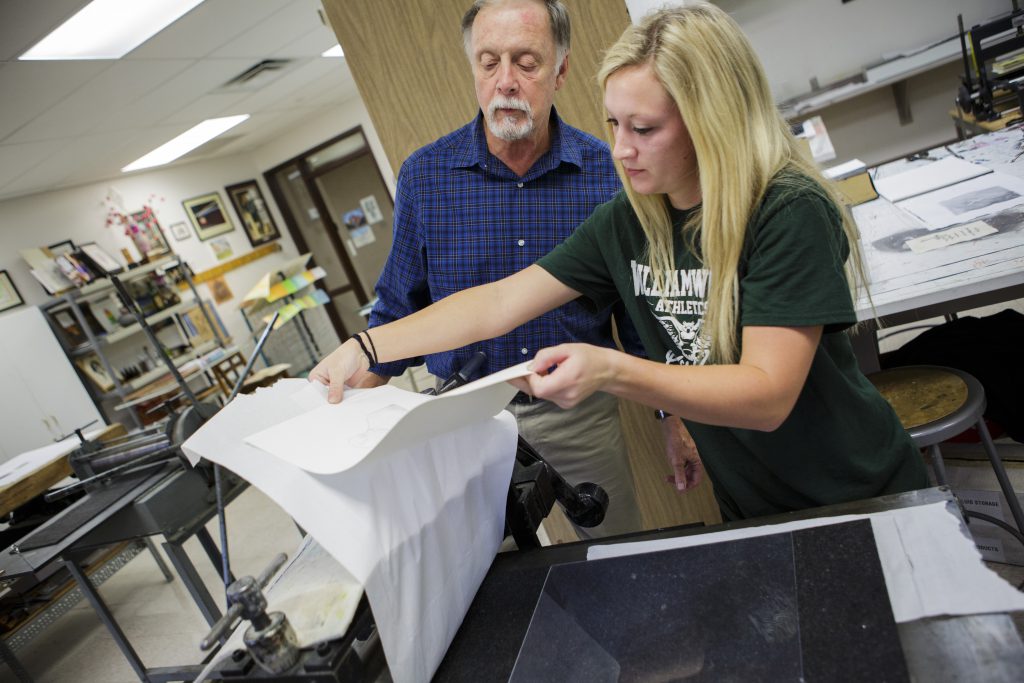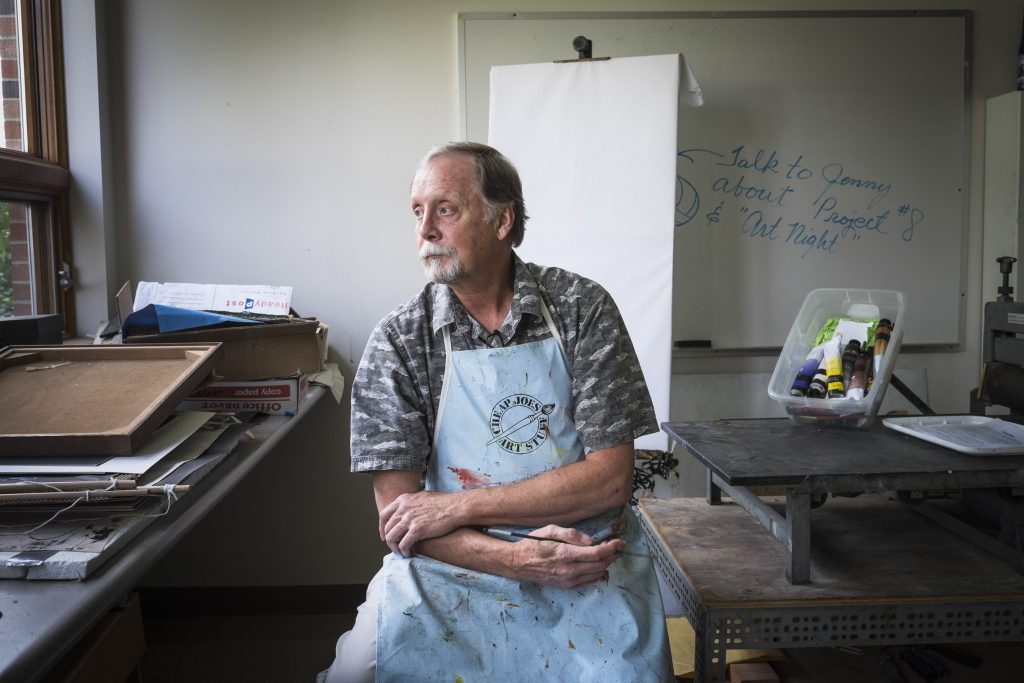Growing up in Nature
I was fortunate to grow up in Southern Missouri, in Springfield, where my father was a professor at Missouri State University. Growing up, there were lakes and streams and rivers. I had a bicycle and a fishing rod and was up at daylight each day and home when it got dark. And I developed more and more of an interest in nature. I discovered artists like John James Audubon and nature artists and wildlife artists like Robert Bateman, and what they were doing really appealed to me. As I grew older I had more of an understanding of the formal aspect of design. I started kind of entertaining ideas of abstract art too. I think the first real incentive I had was a watercolor that I did of a rainbow trout. I set up a still life, setting down the trout and my rod nearby with water in the background, and I thought the whole thing was kind of a beautiful so I took a photo of it and worked from that photo. The watercolor that resulted was the first Missouri trout stamp. So that opportunity opened up more doors. Later I illustrated a book called “Fly fishing: Trout fishing in Missouri,” and travelled around and saw all the streams and rivers. And all the while my interest was growing.
Career Path
I became a Christian and became very interested in ways I could support people in their lives, and wanted to give to people. And so when I was an art director, there was a people-to-people effort I really enjoyed. So I moved away from being only an artist to being an art professor. And now in kind of the final phase of my life, I’ve decided I’m a creative coach and everyone has creative potential and if they can discover that it can be extremely satisfying. It can be a journey for them that is rather spiritual. So I have this little mantra that I communicate in every course, that life is art. Because we have a chance to create a life mural, and one of the great things about art is if you mess up you can just wipe off the paint or erase the drawing. Well, life is the same way. If you believe as I believe, there is forgiveness and there is love and that can wipe the slate clean.
It was very, very challenging becoming a professor. I realized I needed an exhibition record to be a professor. There’s a lot of challenge in exhibiting not just locally but nationally and internationally. My work has been a lot of places, though I haven’t travelled as much as my work has. I had to not only develop skills as a teacher but get recognized as an artist.

The William Woods experience
I’m retired from the art gallery, though I still advise in some of those areas. I advise on the curriculum committee. I’m rather outspoken about diversity. I’m not sure we know how to define it or measure it but I think we’re doing quite well. When you look at Woods Around the World and the LEAD program, both of those programs offer diversity outside of the classroom and I think when students graduate they’re allowed experiences at William Woods that are very helpful with the appreciation for human rights. I’ve also developed a passion for online teaching. There’s a certain asynchronicity to it, as it allows students to think about it and they are not put on the spot. I can see when they’ve gone online at 3 am. And you can see they’ve developed some confidence in what they’re doing. And I think there’s some opportunities especially with written criticism that can be developed online maybe a little more completely than we do in the face-to-face teaching.
I just came from print making class and of all the forms of art I think print making is really an incentive to be inventive. To develop a surface that then comes in contact with paper or another surface. So all the ways a printing surface can be developed and then the opportunity to make multiples of that. We’re going to conclude that class with a print exchange. I’ve had students write to me and say that their collections of prints is the first original art they really get to own. It seems to be a starting place for them. I like water-based painting because water-based is very flexible, and it offers opportunities to do it in different ways. You can handle it like water color or you can thicken it like oil. You can use it as a medium for collage. It’s extremely conducive to individual aesthetic differences. Other classes are Art Appreciation, where we look at diverse cultures and we look at art as a cumulative of human effort. Since the origins of mankind nature has been our muse, so if we destroy our muse, we will destroy our art too. Maybe that’s the one quote I want to be remembered for. All the cultural sharing that is possible, won’t be worth it anymore if our climate is destroyed. We’ve gone through a lot of war and destruction but we’ve also developed a lot of civilization with world class museums.
Focus in the Classroom
 I’m not very formal. I try to get to know every student. I try to allow every student to find a way to be expressive in visual terms and acquire confidence with material. I think it begins with motivation and then they try different materials and then there’s a mastery of certain techniques with certain materials. It’s not easy to teach that way, it takes a lot of effort when you individualize instruction. Your doors always open, your phone number is given out, your email is constant. But then the individual knows that you care and you want to support their potential. That trust, you can’t have anything close to it any other way. And that’s just key I think. I’m really fortunate, I couldn’t teach anything but art. In art, I’m sort of close to the spiritual nature of each person. I don’t try to censor them. I try and share the joy I have for life and that this notion that life is art.
I’m not very formal. I try to get to know every student. I try to allow every student to find a way to be expressive in visual terms and acquire confidence with material. I think it begins with motivation and then they try different materials and then there’s a mastery of certain techniques with certain materials. It’s not easy to teach that way, it takes a lot of effort when you individualize instruction. Your doors always open, your phone number is given out, your email is constant. But then the individual knows that you care and you want to support their potential. That trust, you can’t have anything close to it any other way. And that’s just key I think. I’m really fortunate, I couldn’t teach anything but art. In art, I’m sort of close to the spiritual nature of each person. I don’t try to censor them. I try and share the joy I have for life and that this notion that life is art.
Career Paths for Art Majors
We have two main career paths. Art Education is one that I’m really proud of because the art teachers in Missouri and other states, and one college professor that I can think of, are all products of our department. We’re the only small, private institution I can think of that’s had two of our Art Education majors become award-winning teachers. They received the Missouri Art Teacher of the Year award. And then I have one student who is a tenure-track professor at Missouri State University. And I’ve heard from a number of students who really enjoy their teaching career. The second path is Graphic Design. There is sort of an indirect third path as well, but you need more education. It’s a lengthy process, you have to get an MFA, but in some cases they’ll end up as college professors.

Staying Involved
I used to compete, and recently entered a painting in an international exhibit. All these shows require entry fees, its expensive and you have absolutely no assurance that you’ll be accepted, they’re juried. Sometimes I’ve had paintings be accepted from one show and rejected from another. The jurors have an individual aesthetic. A lot of my nature work, they don’t think that I take much risk, but if they did understand they would see that I’m not just painting what is right in front of me, I’m painting a memory. Realistic nature paintings aren’t always the best chance of getting accepted into certain shows, but I’ve done pretty well so I’m not complaining. I’m at this really great stage in my life now where I can give away a painting every now and then, and don’t have to sell them all. I still do about 50 paintings a year.

